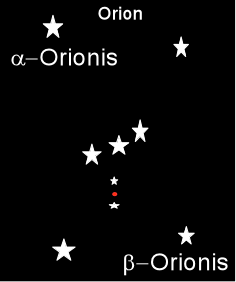Find Ursa Major, which contains the Big Dipper and the pointer stars.

Polaris, which ends the "tail" of Ursa Minor (The Little Dipper), is very close to the North Celestial Pole and moves very little.
The other stars circle counterclockwise around the North Celestial Pole.
The circumpolar constellations never set and never rise. They simply circle in the north.
The easiest circumpolar constellations to recognize are:
Orion is a very easy constellation to recognize.
 Alpha Orionis, or Betelgeuse, and beta Orionis or Rigel are among the brightest stars in the sky. The three stars of the "belt" lie almost exactly on a straight line and draw your eye right away. Finally, this constellation is HUGE.
Alpha Orionis, or Betelgeuse, and beta Orionis or Rigel are among the brightest stars in the sky. The three stars of the "belt" lie almost exactly on a straight line and draw your eye right away. Finally, this constellation is HUGE. Suppose that you see Orion near the eastern horizon at 8pm. If you look for it again at 9pm, you will see that it has moved higher in the sky and farther south. How many degrees of arc has it moved?
It is 2am and you fall asleep while watching the stars on a winter night. Just before you fall asleep, you see Betelgeuse right in line with the top of a nearby cellular phone tower. When you wake up, it has moved. Holding your hand out at arms length, you see that it has moved the width of your fist. How long were you asleep?
What sort of star would not move 360° in one day?
Polaris, for example, hardly moves at all. The other stars of Ursa Minor trace small circles so that, even though the earth turns by 360°, these stars move much less than 360° in the sky.